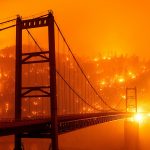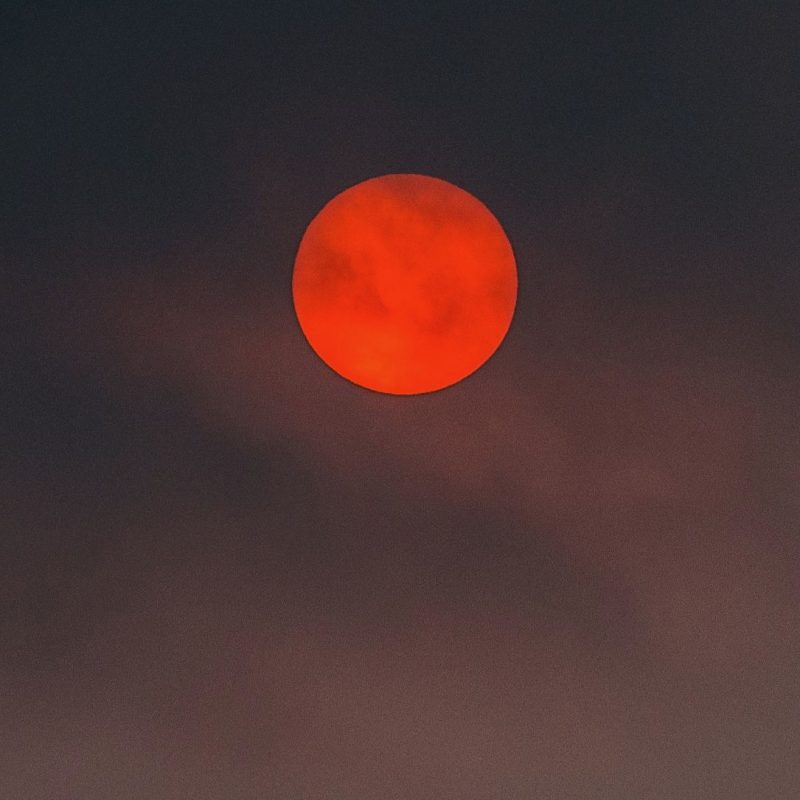

The Bear Fire burned near the Bidwell Bar Bridge in Oroville, California, on Wednesday, September 9, 2020. Image via Noah Berger/ Associated Press/ New York Times.
Les Cowley – who publishes the great website Atmospheric Optics and is surely the world’s best-known living master of the physics of sky phenomena – emailed EarthSky early this morning. He said he’s being asked over and over about the red color of skies in the U.S. West this week, due to the ongoing massive wildfires. His answer below.
The color of our skies is a matter of the sizes of the particles making up our air. It’s also a function of the number of particles per unit volume in air, and to a much lesser extent – during wildfire season – the color of soot itself.
Particles smaller than visible light wavelengths scatter short wavelengths (e.g. blue light) much more strongly than long wavelengths (red). This is known as Rayleigh scattering, named for Lord Rayleigh in the 19th century, who derived the small particle limit. Lord Rayleigh determined that the scattering goes as the inverse fourth power of the wavelength.
Hence, blue light is scattered some 10 to 15 times more than red light. Air molecules scattering in this manner are what generate our blue skies.
Note that the light of even glorious red sunsets still has some transmitted blue. Not all is scattered away!
As particles get bigger they still scatter blue more than red, but the wavelength dependence weakens from the Rayleigh limit of the fourth power. Particles several times larger than light wavelengths scatter all wavelengths more or less equally.
Fresh smoke is an intermediate case. Look at a campfire sideways-on to the sunlight direction, and you’ll see its smoke is blue. If you are unfortunate enough to be downwind and in the smoke, the sun is reddened,
The wildfire smoke over the U.S. West this week is largely in this regime. It scatters away more blue and the sun’s transmitted light is reddened (but not completely denuded of blues).
All this holds for single scattering where a sun ray is scattered by only one particle before reaching the eye. Where the smoke clouds are dense, there is significant multiple scattering. In the limit of an optically thick cloud the light inside the cloud (or sky) becomes a uniform color: that of the incident light before significant multiple scattering. Thus clouds are white inside, and a clear blue sky gets milky white toward the horizon. Multiple scattering will modify the sky colors in San Francisco, for example, to an almost uniform orange-red. It is orange-red because the sunlight reaching the dense smoke has already been reddened by less dense smoke.
Sky colors with multiple scattering get complicated and need mathematical modeling to make predictions.

View at EarthSky Community Photos. | Jim Hatcher in San Diego, California, captured this very red sun on September 7, 2020. The red color was caused by smoke in the air due to wildfires in the West this week.
Bottom line: Wildfires cause red skies because sky color is a matter of particle size, and because wildfires introduce differently sized particles into our air.
from EarthSky https://ift.tt/33kjA0t


The Bear Fire burned near the Bidwell Bar Bridge in Oroville, California, on Wednesday, September 9, 2020. Image via Noah Berger/ Associated Press/ New York Times.
Les Cowley – who publishes the great website Atmospheric Optics and is surely the world’s best-known living master of the physics of sky phenomena – emailed EarthSky early this morning. He said he’s being asked over and over about the red color of skies in the U.S. West this week, due to the ongoing massive wildfires. His answer below.
The color of our skies is a matter of the sizes of the particles making up our air. It’s also a function of the number of particles per unit volume in air, and to a much lesser extent – during wildfire season – the color of soot itself.
Particles smaller than visible light wavelengths scatter short wavelengths (e.g. blue light) much more strongly than long wavelengths (red). This is known as Rayleigh scattering, named for Lord Rayleigh in the 19th century, who derived the small particle limit. Lord Rayleigh determined that the scattering goes as the inverse fourth power of the wavelength.
Hence, blue light is scattered some 10 to 15 times more than red light. Air molecules scattering in this manner are what generate our blue skies.
Note that the light of even glorious red sunsets still has some transmitted blue. Not all is scattered away!
As particles get bigger they still scatter blue more than red, but the wavelength dependence weakens from the Rayleigh limit of the fourth power. Particles several times larger than light wavelengths scatter all wavelengths more or less equally.
Fresh smoke is an intermediate case. Look at a campfire sideways-on to the sunlight direction, and you’ll see its smoke is blue. If you are unfortunate enough to be downwind and in the smoke, the sun is reddened,
The wildfire smoke over the U.S. West this week is largely in this regime. It scatters away more blue and the sun’s transmitted light is reddened (but not completely denuded of blues).
All this holds for single scattering where a sun ray is scattered by only one particle before reaching the eye. Where the smoke clouds are dense, there is significant multiple scattering. In the limit of an optically thick cloud the light inside the cloud (or sky) becomes a uniform color: that of the incident light before significant multiple scattering. Thus clouds are white inside, and a clear blue sky gets milky white toward the horizon. Multiple scattering will modify the sky colors in San Francisco, for example, to an almost uniform orange-red. It is orange-red because the sunlight reaching the dense smoke has already been reddened by less dense smoke.
Sky colors with multiple scattering get complicated and need mathematical modeling to make predictions.

View at EarthSky Community Photos. | Jim Hatcher in San Diego, California, captured this very red sun on September 7, 2020. The red color was caused by smoke in the air due to wildfires in the West this week.
Bottom line: Wildfires cause red skies because sky color is a matter of particle size, and because wildfires introduce differently sized particles into our air.
from EarthSky https://ift.tt/33kjA0t

Aucun commentaire:
Enregistrer un commentaire